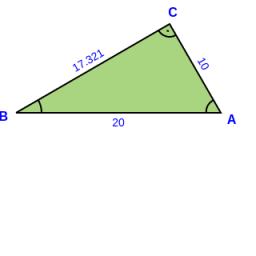Triangle 5851
In a triangle, the first angle is half the second angle, and the third angle is the third of the first angle. How big are the angles in a triangle, and what is the type of triangle?
Final Answer:

Tips for related online calculators
Do you have a linear equation or system of equations and are looking for its solution? Or do you have a quadratic equation?
See also our trigonometric triangle calculator.
See also our trigonometric triangle calculator.
You need to know the following knowledge to solve this word math problem:
algebraplanimetricsUnits of physical quantitiesGrade of the word problem
We encourage you to watch this tutorial video on this math problem: video1
Related math problems and questions:
- The second
 The second angle of a triangle is the same size as the first angle. The third angle is 12 degrees larger than the first angle. How large are the angles?
The second angle of a triangle is the same size as the first angle. The third angle is 12 degrees larger than the first angle. How large are the angles? - Angles in a triangle
 In a triangle, the first angle measures a number plus 45°, and the second angle is 30° less than the first angle. The third angle is two times the number more than the first angle. What are the measurements of each angle of the triangle?
In a triangle, the first angle measures a number plus 45°, and the second angle is 30° less than the first angle. The third angle is two times the number more than the first angle. What are the measurements of each angle of the triangle? - The missing angle
 Find the unknown angle in the triangle. Angles are: 95, 2x+15, x+3. What type of triangle is it?
Find the unknown angle in the triangle. Angles are: 95, 2x+15, x+3. What type of triangle is it? - Six-sided polygon
 There is a six-sided polygon. The first two angles are equal, the third angle is twice (the equal angles), two other angles are trice the equal angle, while the last angle is a right angle. Find the value of each angle.
There is a six-sided polygon. The first two angles are equal, the third angle is twice (the equal angles), two other angles are trice the equal angle, while the last angle is a right angle. Find the value of each angle. - Third angle
 What is the third angle of a triangle if the first two angles have sizes 50° and 60°?
What is the third angle of a triangle if the first two angles have sizes 50° and 60°? - Three-quarters 5783
 A crane loads goods onto the wagons of a freight train. Goods of the first type weigh two and three-quarter tons, goods of the second type two and a quarter tons, goods of the third type one and a half tons, goods of the fourth type three-quarters of a to
A crane loads goods onto the wagons of a freight train. Goods of the first type weigh two and three-quarter tons, goods of the second type two and a quarter tons, goods of the third type one and a half tons, goods of the fourth type three-quarters of a to - Angle at the apex
 In an isosceles triangle, the angle at the apex is 30° greater than the angle at the base. How big are the internal angles?
In an isosceles triangle, the angle at the apex is 30° greater than the angle at the base. How big are the internal angles?
